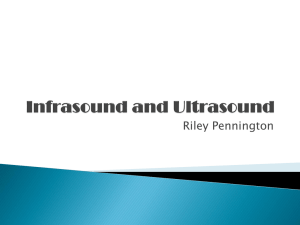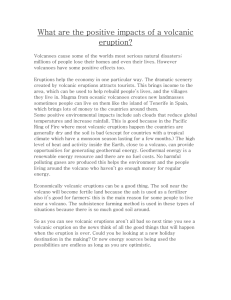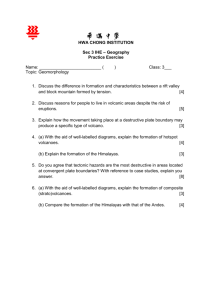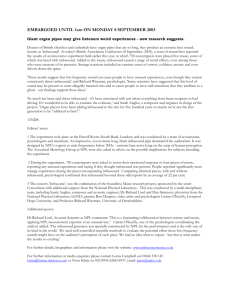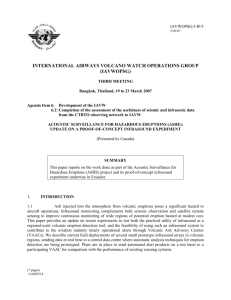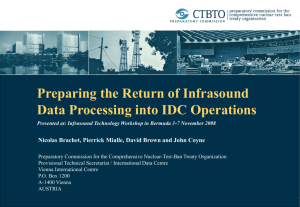IAVWOPSG.4.IP.008.6.en
advertisement
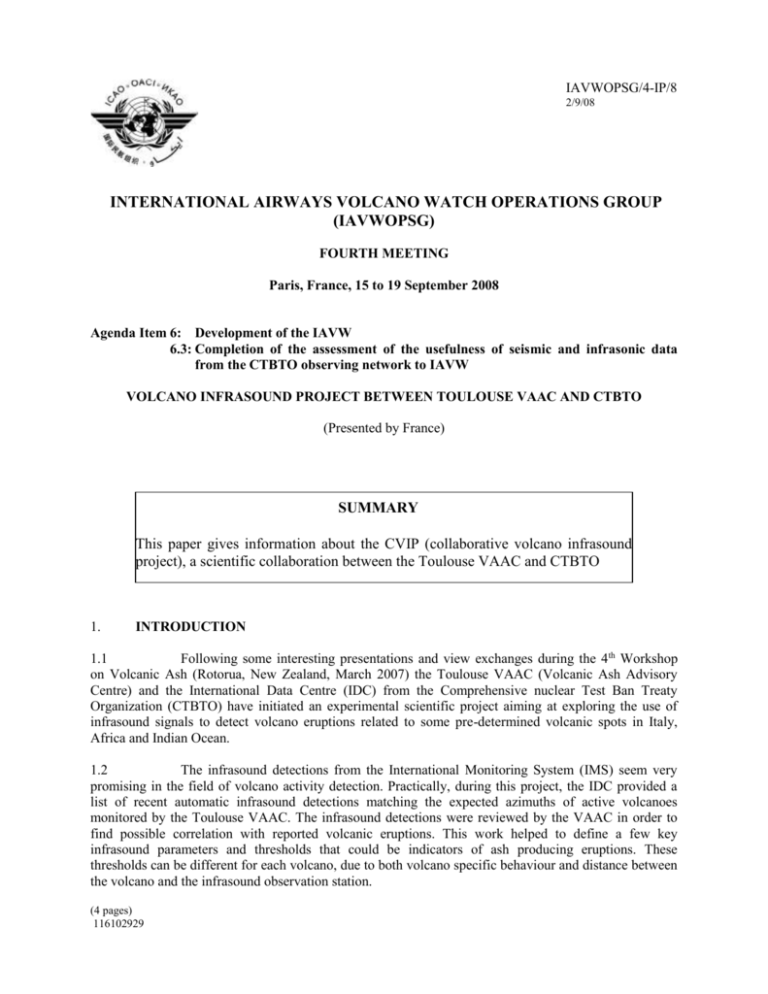
IAVWOPSG/4-IP/8 2/9/08 INTERNATIONAL AIRWAYS VOLCANO WATCH OPERATIONS GROUP (IAVWOPSG) FOURTH MEETING Paris, France, 15 to 19 September 2008 Agenda Item 6: Development of the IAVW 6.3: Completion of the assessment of the usefulness of seismic and infrasonic data from the CTBTO observing network to IAVW VOLCANO INFRASOUND PROJECT BETWEEN TOULOUSE VAAC AND CTBTO (Presented by France) SUMMARY This paper gives information about the CVIP (collaborative volcano infrasound project), a scientific collaboration between the Toulouse VAAC and CTBTO 1. INTRODUCTION 1.1 Following some interesting presentations and view exchanges during the 4th Workshop on Volcanic Ash (Rotorua, New Zealand, March 2007) the Toulouse VAAC (Volcanic Ash Advisory Centre) and the International Data Centre (IDC) from the Comprehensive nuclear Test Ban Treaty Organization (CTBTO) have initiated an experimental scientific project aiming at exploring the use of infrasound signals to detect volcano eruptions related to some pre-determined volcanic spots in Italy, Africa and Indian Ocean. 1.2 The infrasound detections from the International Monitoring System (IMS) seem very promising in the field of volcano activity detection. Practically, during this project, the IDC provided a list of recent automatic infrasound detections matching the expected azimuths of active volcanoes monitored by the Toulouse VAAC. The infrasound detections were reviewed by the VAAC in order to find possible correlation with reported volcanic eruptions. This work helped to define a few key infrasound parameters and thresholds that could be indicators of ash producing eruptions. These thresholds can be different for each volcano, due to both volcano specific behaviour and distance between the volcano and the infrasound observation station. (4 pages) 116102929 -2- IAVWOPSG/4-IP/8 2. DISCUSSION 2.1 For each volcano, the different infrasound parameters are: detection date and time, estimated time of a possible eruption (assuming a 300m/s infrasound wave propagation), duration (in seconds), azimuth angle, horizontal speed, central frequency, and Signal-to-Noise Ratio (SNR) of the detected signal. Accuracy in detection time and duration is 10s and the maximum duration is 30mn. Example of IDC automatic infrasound detections recorded at IS32, Kenya on 1 January 2008 and related to the eruption of Ol Doinyo Lengai,Tanzania (expected station-to- volcano azimuth is 212 degres) : Detection time Exp.Eruption Duration(s) Azimuth(deg) Speed(m/s) C.Frequency(Hz) SNR 01/01/08 17:32:50 17:21 110 215.0 345 1.42 0.9 01/01/08 17:38:00 17:27 100 215.7 357 1.36 1.8 01/01/08 18:20:50 18:09 550 214.7 340 1.81 31.3 01/01/08 18:30:00 18:19 1800 214.8 348 1.84 19.6 01/01/08 19:00:00 18:49 1800 214.6 346 1.85 32.4 01/01/08 19:30:00 19:19 480 214.5 345 1.24 24.1 -3- IAVWOPSG/4-IP/8 Map of selected volcanoes: Courtesy of CTBTO/IDC 2.2 Considering the large number of infrasound detections, it is necessary to apply thresholds on frequency duration, horizontal speed and SNR in order to keep only the most relevant detections. A first basic filter can be applied on frequencies: Most of the large volcanic eruptions observed have been detected with a frequency value around 1.5 Hz. Low frequencies signals below 0.2Hz are mainly attributed to ocean swell or mountain associated waves (air flow over mountain ranges), and high frequency signals above 2Hz are usually due to very local infrasound sources. Besides, it is not useful to take into consideration transient signals lasting less than 60 seconds or detections with horizontal speed exceeding 400m/s interpreted as coming from local phenomena not related to volcanic activity (e.g. commercial aircraft flying at low level near Nairobi detected by IS32). 2.3 What emerges at first sight from the infrasound data analysis is the disparity between the different volcanoes. If the number of detections for Etna and Stromboli is relatively small (closest IMS station: IS26, Germany 1250km), it is huge for Ol Doinyo Lengai in Tanzania (closest IMS station: IS32, Kenya 200km) with or without ash rejected in the atmosphere (more than 3700 detections from 1 January to 15 March 2008!). For this very infragenic volcano, it is therefore necessary to apply a supplementary filter based on energy in order to keep only the infrasound detections with the largest SNR values (see section 2.7). 2.4 One limitation of this preliminary study comes from the small number of reported volcanic eruptions during the selected period (November 2007 - March 2008). The only volcanoes within the Toulouse VAAC area of responsibility having had an eruption producing significant or at least detectable volcanic ash since November 2007 are Mt. Etna, Nyiragongo and Ol Doinyo Lengai. 2.5 Between November 2007 and March 2008, the main significant eruption of Mt. Etna producing a volcanic ash plume occurred on 23 November. A few days earlier (on 20 and 22 March 2008), infrasound signals were detected at IS26, Germany with central frequencies around 1Hz and 60 second durations. These detections are very interesting as they may be precursors for the eruption of 23 March. A similar observation was made in early January 2008 when infrasound signals were detected at IS26 two days before Mt Etna started to reject volcanic gas plumes. IAVWOPSG/4-IP/8 -4- 2.6 Nyiragongo, Democratic Republic of Congo (DRC) is a very steady producer of volcanic gases (first volcanic SO2 producer in the world) more frequently without volcanic ash. It seems that some infrasound detections at IS32 (840km from the volcano) could possibly be related to the volcanic activity, even without any ash emission. However, correlating infrasound detections and volcanic ash rejection in the atmosphere is not an easy task for this volcano, considering the frequent bad weather conditions in this area (deep convection cumulonimbus clouds growing daily in this African equatorial region) which may block the visual observations of ash plumes. This is also true for others African volcanoes in DRC and Tanzania. 2.7 The Ol Doinyo Lengai volcano leads to a nearly permanent flux of infrasound detections at IS32. A basic data filtering based on SNR values seems to be promising: By only taking into consideration the high SNR detection values (above 150), we managed to limit the number of detections to a hundred for the period from 1 January to 15 March 2008. Furthermore, all known ash producing eruptions for this volcano correspond to SNR value of more than 150 at the time or during the few hours/days preceding the eruption. For example, the volcanic ash emission which started on 15 February 2008 was preceded by volcanic gas emission on 13 February, and high SNR infrasound signals were detected on 9 and 13 February. The volcanic activity lasted for several weeks and large SNR detections were observed all along this period. 2.8 On the other hand, high SNR infrasound signals have been reported without any observations of volcanic ash. However, it seems that these infrasound detections may be correlated to strong surface activity from the Ol Doinyo Lengai; for example, the high SNR detection values on 11, 12 and 14 January 2008 are to be related to the lava flow and ‘lapilli rain’ reported by a visitor in the vicinity of the volcano summit. 3. CONCLUSION 3.1 Even if the collaborative project between the Toulouse VAAC and CTBTO lasted a few months and concerned only a limited number of significant volcanic eruptions, the information obtained by the analysis of IMS infrasound data is encouraging in terms of possible use for the detection of explosive volcanic eruptions. As far as the Toulouse VAAC is concerned, infrasound data about Italian and Tanzanian volcanoes is clearly of interest. This first experience is worth being extended to a longer duration in order to better understand the correlation between explosive eruption events and their different signatures in the infrasound detections. 4. 4.1 ACTION BY THE GROUP The group is invited to note the content of this document. — END —
